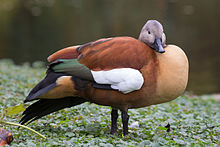South African shelduck
| South African shelduck | |
|---|---|

| |
| Adult male. | |
| Scientific classification | |
| Kingdom: | |
| Phylum: | |
| Class: | |
| Order: | |
| Family: | |
| Subfamily: | |
| Genus: | |
| Species: | T. cana
|
| Binomial name | |
| Tadorna cana (Gmelin, 1789)
| |
The South African shelduck or Cape shelduck (Tadorna cana) is a species of shelduck, a group of large goose-like birds which are part of the bird family Anatidae, which also includes the swans, geese and ducks. This is a common endemic species to South Africa.[2]
This is a 64 cm long bird which breeds in southern Africa, mainly in Namibia and South Africa. In the southern winter, many birds move north-east from the breeding range to favoured moulting grounds, where sizable concentrations occur.
This species is mainly associated with lakes and rivers in fairly open country, breeding in disused mammal holes, usually those of the aardvark. Pairs tend to be very nomadic when not in breeding season.[2]

Adult South African shelduck have ruddy bodies and wings strikingly marked with black, white and green. The male has a grey head, and the female has a white face and black crown, nape and neck sides. Note the colour on the females head is highly variable.[2] In flight hard to distinguish from Egyptian geese.[2] Juveniles are duller in appearance. Young females lack the white on the head, excluding white eye circles. Males make a deep honk or hoogh call while the female tends to produce a louder, sharper hark.[2]
South African shelduck is one of the species to which the Agreement on the Conservation of African-Eurasian Migratory Waterbirds (AEWA) applies.
The genus name Tadorna comes from Celtic roots and means "pied waterfowl", essentially the same as the English "shelduck".[3]
References
- ^ Template:IUCN
- ^ a b c d e Newman, Vanessa (2010). Newman's Birds of Southern Africa. Cape Town, South Africa: Pippa Parker. p. 112. ISBN 9781770078765.
- ^ Kear, Janet (2005). Ducks, Geese, and Swans. Oxford University Press. p. 420. ISBN 0-19-861008-4.
- Ian Sinclair, Phil Hockey and Warwick Tarboton, SASOL Birds of Southern Africa (Struik 2002) ISBN 1-86872-721-1
- Madge and Burn, Wildfowl ISBN 0-7470-2201-1

